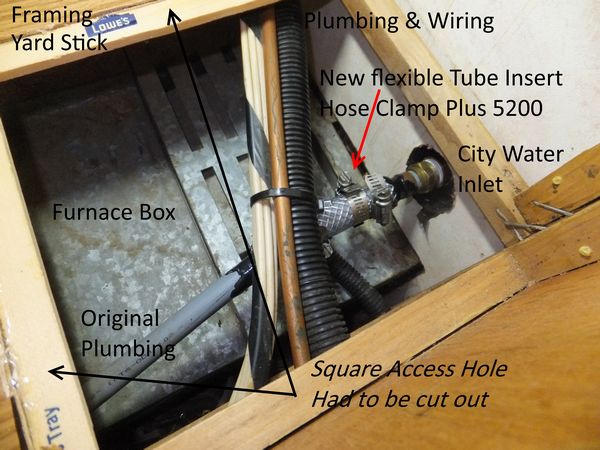OK, yesterday I promised you part two... Oops day before yesterday. We had a massive storm to deal with first.
This area was hit with wild wacky weather that required me to spend a ton of time reorganizing and taking measures to have the least amount of damage. I had so much scattered outside because this motorhome is shrinking. After 7 years, I have a smidgen of cabin fever! So whenever possible, I like to live outdoors to give the illusion of more room.
The last few weeks, I have been consumed with trying to get running water restored to the inside of my motorhome. It's all about 95% done now and I am jumping up and down with EXCITEMENT because I have RUNNING water again. Hot and cold INSIDE my motorhome and nothing is leaking inside anymore.
This is cause for celebration! Running water! WOW! I am so excited and happy!
I still have some soft flooring from the water damage, but that's life and maybe next year... ha ha ha... in my dreams! That will be dealt with. Maybe not. I try to keep my motorhome patched up and working but it's old and I am slower and weaker than I prefer, so all things take time.
Patience.
It's maddening!
I woke up alive, I have a place to live and now I have running water! Hot and cold! I can shower, I can wash dishes, I can bathe the stinky little dog. I can flush the toilet without first having to go fetch a bucket of water. Sometimes there isn't time to go fetch the water first... if you get my drift.
Luckily my old buddy showed up to lend a hand and that has been serendipitous indeed. We both hail from former lives spent in far flung ports, tiny remote backward islands and living on old sailboats at anchor (not marinas). In other words we're used to doing something with nothing and happily making do. Thinking outside the box. Get things done in often unconventional ways. We've worked together on projects before. Sometimes we make it worse, but mostly we make it much better.
Believe me I would rather just hire someone to come do it all, but that wasn't an option at this point and time.
Think outside the box!
The leaky hot water tank was repaired with
JB underwater weld. That was after the first repair with quick setting Marine-tex strangely failed. What? Our work was less than perfect?
I was avoiding replacing the hot water tank because it's installed in an area that would require extensive work (read that as heavy labor cost!) to remove and replace. That was well beyond our capabilities and tools. They stuffed it in a tight compartment among all the electrical wiring for the entire rig plus copper and plastic plumbing. If an RV repairman spent 10-20 hours at $80-$110 per hour, the cost could quickly escalate!
To complicate matters, my propane only hot water tank has a
400 watt electric kit added. We put that in when I started workamping years ago so I could have hot water 24/7 on electric. The kit was only about $60 at the time, cost hasn't changed much since then, but for 5 years the electric has worked flawlessly. So why even have a propane hot water heater at all?
 |
| This kit for converting a propane hot water tank to optional electricity is sold at Amazon. |
Well, it's handy at times. Last summer I camped with friends using reduced electricity, in that case I can turn off my electric hot water and anything else I don't need so my electric consumption is reduced to the minimal. If you are a non-Rv-er (or new to RVing) reading this, it sounds complicated. But imagine if you were running your entire home off your neighbor's extension cord to a regular outlet. You would have to substantially reduce your electric usage to do this.
Before that I had to cycle the hot water on and off, to conserve propane. I have to drive the entire rig to top up my built-in propane tank. There just isn't room to add a spare removable propane tank. Even so, I don't have a car, so changing out a hefty propane tank with a bicycle isn't really an option. At that time I didn't even have a bicycle. The nearest propane fill was 12 miles one way from my workamping so adding the electric kit saved me both gasoline and propane. .
Buying a hot water tank that is already set up for electric and propane is 1000 watts or more for just the electric side, rather than the 400 efficient watts the kit come with. My RV can't handle that because it's 30amp and not 50amp. So I would have to contemplate unwiring and rewiring the kit from the old propane water heater to a new propane one. More work, more problems. Good grief.
I am living on a shrinking tiny efficient budget. Very efficient. Squeaky efficient. But that's just the way things are for now, so no use fussing, just wake up and deal with it. Be happy!
Then the city water connection which first was leaky, then broke completely. Horrors! I went through three different parts. First one was wrong part (after taking apart motorhome and seeing it would not work). Second part arrived by mail order damaged so badly it couldn't be cobbled into use. Third part arrived (at more cost, but same part) and while it's flimsy compared to the old original part, I've since discovered they don't manufacture the old sturdy original part anymore.
This is an alarming problem widespread in the RV industry. The RV manufacturers (and RV part manufacturers) are seemingly of the notion of a throw-away society. Why fix it when you can just buy another new RV and toss out the old RV?
Salesman and RV manufacturers don't want us to repair our used rigs, they want us to buy new rigs.
When we tried to install
the new city water connection, it was a different part, so we had to adjust for that. It was also in a no man's land inside the wall, underneath a hard to reach corner cabinet in the galley. It was connected to hard plastic plumbing.
The old part wouldn't come off easily. Once it finally came off, we realized we had the wrong part. That began the second, third and fourth lengthy delay of no running water that kept snowballing into longer delays. When the third part finally arrived, it was impossible to install without even more modifications.
By then we had cut out an access hole, framed it up with pieces from my wooden yard stick with glue and screws, so that once it was all repaired, the access hole could be covered again. The plumbing was nearly impossible to reach and install the new part, even with the new access hole, so thinking like a sailor. I suggested we hack saw the hard plastic plumbing in the middle, buy flexible tubing and stainless steel hose clamps, then cobble it all back together again.
Amazingly, this turned out to work beautifully. Ironically a $10 coupon for
Ace Hardware was floating around the RV, and we were able to get the parts at Ace hardware using the coupon. How delightful!
OK, the rest is in pics just to entertain you...
In this picture below, you are looking inside the cabinet in the corner of my RV kitchen.
In this picture, you are looking at the same cabinet, with the access plate (in the above picture) removed so you can see what we were up against in trying to fit this mess in. Where it says City water inlet, is where it connects through the outside wall of the motorhome.
As you can see, electrical wiring supplying the motorhome, plumbing from copper and plastic is going in several directions, plus the furnace, are all crammed in there.
By hack-sawing the gray plastic plumbing, we could then attach the new water inlet to a section of the plastic plumbing, shove that in the outside hole, then connect it back up to the other side of the hard plastic plumbing with flexible tubing and hose clamps.
It worked! Which to add to the workload, the new city water inlet, was smaller than the old one. So some marine-tex filler had to be added to that round hole (through the outside wall) to make it fit right. Good grief.
This entire cabinet is actually accessed through another new door that was installed behind the dining booth to access that corner of the kitchen cabinet. This was done a few years ago, because things would get "lost" in the cabinet and I was always fighting with sticks trying to get things back within reach.
Trying to reach that area through the cabinet under the sink on the other side of the counter top, was impossible unless I grew my arms to be 4 feet long.
This cabinet shown below is hidden by the back cushion of my dining booth. When the entire plumbing mess was put back together, I still have access and use of that area for storing useful things like food for dog and human.
There you have it!
More than you ever wanted to know about
RV plumbing.
Thank you for stopping by today.








































